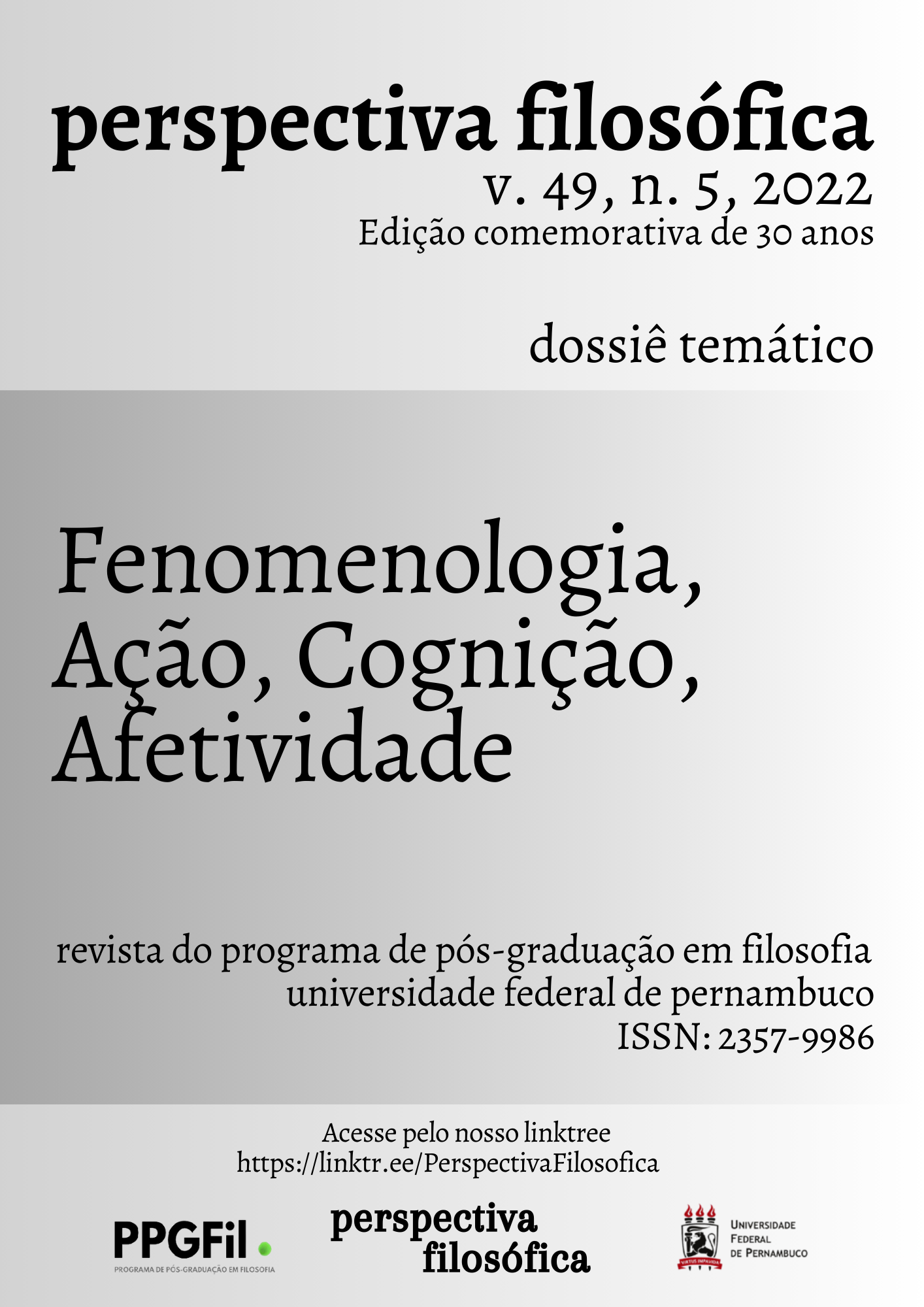Emoções animais não-humanas: tipo homológicos ou funcionais?
DOI:
https://doi.org/10.51359/2357-9986.2022.256754Palavras-chave:
emoções não-humanas, funcionalismo, pensamento homológico, realização múltiplaResumo
Em nossa vida diária, atribuímos emoções a animais não-humanos. No entanto, os compromissos ontológicos que isto implica ainda estão em discussão. Particularmente, os filósofos ainda debatem se as considerações sobre os mecanismos subjacentes às emoções são necessárias ou não para atribuiras emoções a animais não humanos. Aqui, eu defendo que tais considerações não são suficientes e que uma perspectiva funcionalista é mais frutíferado que seu principal concorrente, a visão do pensamento homológico. Para fazer isto, considero os resultados da psicologia experimental sobre a atribuição de emoções a animais não humanos e distingo duas questões relativas a tais emoções. Em seguida, discuto o funcionalismo e o pensamento homológico, afirmando que o pensamento homológico exclui desde o início hipóteses empíricas promissoras, resultando em uma posição mais limitada do que o funcionalismo. Assim, o funcionalismo herda muitos benefícios do pensamento homológico, ao mesmo tempo em que fornece bases mais produtivas.
Referências
Adolphs, R. (2016). How should neuroscience study emotions? By distinguishing emotion states, concepts, and experiences. Social Cognitive and Affective Neuroscience, 49(4), 24–31. https://doi.org/10.1093/scan/nsw153.
Adolphs, R., & Andler, D. (2018). Investigating Emotions as Functional States Distinct From Feelings. Emotion Review, 10(3), 191–201. https://doi.org/10/gfn9rs.
Clark, J. A. (2010). Relations of homology between higher cognitive emotions and basic emotions. Biology & Philosophy, 25(1), 75–94. https://doi.org/10.1007/s10539-009-9170-1.
Clark, J. A. (2013a). Integrating basic and higher-cognitive emotions within a common evolutionary framework: Lessons from the transformation of primate dominance into human pride. Philosophical Psychology, 26(3), 437–460. https://doi.org/10.1080/09515089.2012.659168.
Clark, J. A. (2013b). Intersections between development and evolution in the classification of emotions. Developmental Psychobiology, 55(1), 67–75. https://doi.org/10.1002/dev.21063.
Ekman, P. (1992). An argument for basic emotions. Cognition & Emotion, 6(3), 169–200. https://doi.org/10.1080/02699939208411068.
Ekman, P., & Cordaro, D. (2011). What is Meant by Calling Emotions Basic. Emotion Review, 3(4), 364–370. https://doi.org/10.1177/1754073911410740.
Ereshefsky, M. (2007). Psychological categories as homologies: Lessons from ethology. Biology & Philosophy, 22(5), 659–674. https://doi.org/10.1007/s10539-007-9091-9.
Fugate, J. M. B. (2015). Evolutionary Constraints and Cognitive Mechanisms in the Construction of an Emotion. In L. F. Barrett & J. A. Russell (Eds.), The Psychological Construction of Emotion (pp. 399–426). The Guilford Press.
Griffiths, P. E. (1997). What Emotions Really Are: The Problem of Psychological Categories. University of Chicago Press.
Griffiths, P. E. (2006). Function, Homology, and Character Individuation. Philosophy of Science. https://doi.org/10.1086/510172.
Izard, C. E. (1992). Basic emotions, relations among emotions, and emotion-cognition relations. Psychological Review, 99(3), 561–565.
Izard, C. E. (2007). Basic Emotions, Natural Kinds, Emotion Schemas, and a New Paradigm. Perspectives on Psychological Science, 2(3), 260–280. https://doi.org/10.1111/j.1745-6916.2007.00044.x.
LeDoux, J. E. (2013). The slippery slope of fear. Trends in Cognitive Sciences, 17(4), 155–156. https://doi.org/10.1016/j.tics.2013.02.004Lindquist, K. A., Wager, T. D., Kober, H., Bliss-Moreau, E., & Barrett, L. F. (2012). The brain basis of emotion: A meta-analytic review. Behavioral and Brain Sciences, 35(03), 121–143. https://doi.org/10.1017/S0140525X11000446.
Loaiza, J. R. (2021a). Emotions and the problem of variability. Review of Philosophy and Psychology, 12(2), 329–351. https://doi.org/10.1007/s13164-020-00492-8.
Loaiza, J. R. (2021b). Functionalism and the emotions. The British Journal for the Philosophy of Science. https://doi.org/10.1086/715207.
Morris, P., Doe, C., & Godsell, E. (2008). Secondary emotions in non-primate species? Behavioural reports and subjective claims by animal owners. Cognition & Emotion, 22(1), 3–20. https://doi.org/10.1080/02699930701273716.
Morris, P., Lesley, S., & Knight, S. (2012). Belief in Animal Mind: Does Familiarity with Animals Influence Beliefs about Animal Emotions? Society & Animals, 20(3), 211–224. https://doi.org/10.1163/15685306-12341234.
Panksepp, J. (1998). Affective neuroscience: The foundations of human and animal emotions. Oxford Univ. Press.
Panksepp, J. (2011). The basic emotional circuits of mammalian brains: Do animals have affective lives? Neuroscience and Biobehavioral Reviews, 35(9), 1791–1804. https://doi.org/10.1016/j.neubiorev.2011.08.003.
Piccinini, G. (2004). Functionalism, computationalism, and mental states. Studies in History and Philosophy of Science Part A, 35(4), 811–833. https://doi.org/10.1016/j.shpsa.2004.02.003.
Piccinini, G. (2010). The Mind as Neural Software? Understanding Functionalism, Computationalism, and Computational Functionalism. Philosophy and Phenomenological Research, 81(2), 269–311. https://doi.org/10.1111/j.1933-1592.2010.00356.x.
Place, U. T. (1956). Is Consciousness a Brain Process? British Journal of Psychology, 47(1), 44–50. https://doi.org/10.1111/j.2044-8295.1956.tb00560.x.
Putnam, H. (1960/1997). Mind and machines. In Mind, language and reality (pp. 362–385). Cambridge University Press.
Putnam, H. (1967/1997). The nature of mental states. In Mind, language and reality (pp. 429–440). Cambridge University Press.
Smart, J. J. C. (1959). Sensations and Brain Processes. The Philosophical Review, 68(2), 141–156. JSTOR. https://doi.org/10.2307/2182164.
Spunt, R. P., Ellsworth, E., & Adolphs, R. (2017). The neural basis of understanding the expression of the emotions in man and animals. Social Cognitive and Affective Neuroscience, 12(1), 95–105. https://doi.org/10/gf26mm.
Wilkins, A. M., McCrae, L. S., & McBride, E. A. (2015). Factors affecting the Human Attribution of Emotions toward Animals. Anthrozoös, 28(3), 357–369. https://doi.org/10.1080/08927936.2015.1052270.
Downloads
Publicado
Edição
Seção
Licença
A Revista Perspectiva Filosófica orienta seus procedimentos de gestão de artigos conforme as diretrizes básicas formuladas pelo Conselho Nacional de Desenvolvimento Científico e Tecnológico (CNPq). http://www.cnpq.br/web/guest/diretrizesAutores que publicam nesta revista concordam com os seguintes termos:
Os autores mantém os direitos autorais e concedem à revista o direito de primeira publicação, sendo o trabalho simultaneamente licenciado sob https://creativecommons.org/licenses/by/4.0/deed.pt_BR que permite o compartilhamento do trabalho com reconhecimento da autoria e publicação inicial nesta revista.
Os autores têm autorização para assumir contratos adicionais separadamente, para distribuição não-exclusiva da versão do trabalho publicada nesta revista, com reconhecimento de autoria e publicação inicial nesta revista (Consultar http://opcit.eprints.org/oacitation-biblio.html).

Esta revista está licenciada com uma Licença Creative Commons Atribuição 4.0 Internacional.













